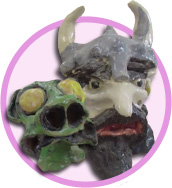Using Clay to Explore the Creatures and Characters from J.R.R. Tokien’s The Hobbit
Overview
 As a trans-curricular “maker project” students complete a novel study on J.R.R. Tolkien’s fantasy classic The Hobbit and then enrich their understanding through an artistic, creative project with encourages comprehension, design, and creation. Student will create sculptures out of low-fire clay and glazes based on creatures and characters from Tolkien’s Middle Earth. Teachers may want to try pairing this with an inquiry-style, student directed approach to the traditional novel study by having students use a question generator and devise their own questions. As an idea, have the students put their questions up on large photocopied, coloured map of “Middle Earth” and have students answer the “Quest for Questions” as they journey to Lonely Mountain
As a trans-curricular “maker project” students complete a novel study on J.R.R. Tolkien’s fantasy classic The Hobbit and then enrich their understanding through an artistic, creative project with encourages comprehension, design, and creation. Student will create sculptures out of low-fire clay and glazes based on creatures and characters from Tolkien’s Middle Earth. Teachers may want to try pairing this with an inquiry-style, student directed approach to the traditional novel study by having students use a question generator and devise their own questions. As an idea, have the students put their questions up on large photocopied, coloured map of “Middle Earth” and have students answer the “Quest for Questions” as they journey to Lonely Mountain
Rationale (Why we are doing this?)
When students are able to show understanding and comprehension through design and creation in trans-curricular style the depth of learning is increased.
Materials/Resources
- L211 low fire clay (one box is 20 kg) and easily give a 28 student class one “butter brick” size portion.
- About 4 kg of plastecine
- 28 boards, chopsticks, spoons, re-purposed small, plastic milk containers.
- Gloves and old sued fishing line
- A dozen common colours of low fire glaze
- Brushes both small and medium for coverage and detail.
Context and Background Knowledge
It is beneficial for the students to have some experience with clay and basics such as “scoring and attaching,” smoothing, and keeping the material moist. It can also be helpful to have them “warm-up” with plastecine (Never put plastecine in the kiln). Also, have students build a character and creature “profile” while encouraging students to interpret the creature in their own way. Tolkien never over describes his creature and their numerous artistic renditions of his creations.
Curricular Connections (Competencies and Content)
| Identify and use appropriate tools, technologies, and materials for production | (ADST-Grade 6) |
| Make a plan for production that includes key stages, and carry it out, making changes as needed. | (ASDT-Grade 6) |
| Use materials in ways that minimize waste | (ADST-Grade 6) |
| Reflect on their design thinking and processes | (ADST-Grade 6) |
| Evaluate their product against criteria | (ADST-Grade 6) |
| Processes, materials, movements, technologies, tools, strategies, and techniques to support creative works | (Arts-Grade 6) |
| Access information and ideas for diverse purposes and from a variety of sources and evaluate their relevance, accuracy, and reliability | (Language Arts-Grade 6) |
| Think critically, creatively, and reflectively to explore ideas within, between, and beyond texts | (Language Arts–Grade 6) |
| Respond to text in personal, creative, and critical ways | (Language Arts–Grade 6) |
Explore + Understand + Create (6 weeks to complete novel study and 6 classes for claywork)
- Students complete a novel study on J.R.R. Tokien’s The Hobbit. Adaptations can be audiobooks, graphic novels, cartoon and movie versions of the novel. These can be useful in “bringing this story” to a range of students. Try “The Quest for Questions” approach to this novel and have the student stick their questions on an enlarged map of “Middle Earth”.
- Students spend one class brainstorming to create a description of their creature from novel details.
- Students spend one class “prototyping” with plastecine while the teacher models scoring and attaching and hollowing techniques. Also provide students with information on clay and the vitrification process.
- Teacher pre-cuts clay the size of a “brick of butter” and dispenses tools, water, etc.
- Students create. Cover work in a plastic bag and sprinkle with water until complete. This way clay can be workable for around 5 days.
- Allow creations to dry (4-7days….can be sped up in a warm, dry place. Be cautious, it is very fragile at this time.
- First fire..allow to cool. Then glaze…but not the bottoms.
- Glaze fire and display
Applications/Adaptations/Extensions
- Can be adapted for any novel but is highly suitable for Sci-Fi and Fantasy where there are fictional creatures.
- Students can create a landscape for their characters with train model set materials, lego, etc.
- Students create a display and give an “art talk” describing their character.
